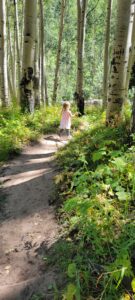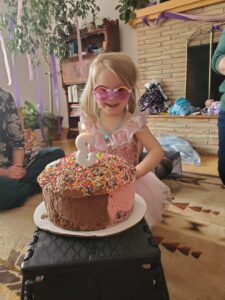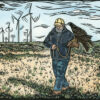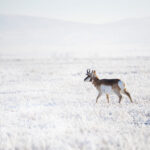Lessons from my children in the context of climate change
By Corrie Knapp
When she was a baby, my eldest daughter had a strong latch and I enjoyed focusing on her breathing and feeling my milk let down. Allowing myself into this flow that was both release and connection at the same time was a lesson for me, the first of many. She would look up at me, her small hand caressing my arm as she nestled in. So young, and intuitively, she knew how to show love. Many mornings I sat, legs up on the glider, my girl tucked into my arm, seeing the first light of the day enter the room as I reached for a scientific article.
As a new and untenured professor, I read while my daughter fed. I study how human communities and the ecosystems they depend on adjust to a changing climate, now and in the future. At the beginning of my career, I said that I studied “climate adaptation,” but when I had children, I realized that what I cared about was far more ambitious than that. It wasn’t that I wanted my children to adapt and survive. I wanted them to thrive.
When I read my first International Panel on Climate Change (IPCC) report in 2003, it was clear that because of the long lifespan of greenhouse gases in the atmosphere, some amount of climate change would happen even if we stopped all future human emissions. Over the years, I recognized that mitigation—reducing greenhouse gas emissions—wasn’t happening quickly enough to avoid significant negative effects of climate change. Mitigation is critically important, but I wanted to work at the grassroots level, helping empower communities to plan for their future and implement local strategies.

Adaptation requires change. Often, the solutions posed are short-term coping mechanisms and disappointingly incremental. A rancher unable to graze livestock because of a megadrought might “adapt” by buying hay. An indigenous community confronted with warming summers and breakdown of traditional food storage might “adapt” by purchasing a community freezer. These actions deal with immediate risk, but they don’t address the root causes of climate change—the structures, systems, and cultural norms that we have all internalized. We need a new way of looking at the world, one that helps us make the changes we need, including reducing our emissions and consuming fewer resources, but also enriching our lives and relationships.
My daughter as a baby was a good feeder and a social girl: she paused every few minutes, liked to make eye contact with me. I would meet her gaze and try to align the pure blue of her eyes with the staggering forecasts of a warmer future, wondering how we would we get through this together. I wanted to have all the answers for her, but I still don’t. Instead, I continue to do what all parents do: I try to control what I can, answer the many questions she and her sister have, and listen to what they are trying to show me. My children are three and six now, and as I’ve watched them grow, they have given me new eyes to see with. They haven’t internalized the systems, structures, and norms that I have. Instead, they offer a new perspective on some of the deeper levers of change that could lead to a future where we all thrive.
The first lesson on thriving my children taught me was about being present, which allows us to moderate stress, remember and recognize our connection with the natural world, and adapt from a place of groundedness. I am not always good at slowing down and paying attention to what is around me, but my kids are. Before we had them, my husband and I loved to hike far and fast on weekends, and when we had kids, we were slow to adjust. For years, our expectations let us down and turned our children into hooligans. We would get a quarter mile in three hours and our girls, riding on our shoulders, would rip out the hair at the top of our heads from holding on too tightly. We ran out of snacks in the first 15 minutes, and there was usually at least one potty accident. We came back with headaches and drove silently home. Finally, we just decided to explore—no timelines, no destination, just attention to where our children’s feet took them and what they wanted to watch.
Last time we were out, we balanced on precarious rocks by the side of a stream and felt the icy cold water running over our toes. My older daughter watched the water as it tumbled, gurgled, and flowed over smooth rocks speckled with sunlight. “Is it always like this here?” she asked, and I breathed it in with her, noticing the light dappled on the water and broken by trees, the deep pool near our feet where we could see small silver fish darting, the smell of warm skin, the hush of the stream with its never-ending waters. I was silent. I looked her in the eye and I knew that she felt the same peace as I did, knowing that it would be here even when we left, that we would both close our eyes back in town—before I started a Zoom meeting or she waited in line for lunch at school—and return to the awareness of this place. If collectively we could act from a place of connection with our ecosystems and each other, the choices we make around adaptation would be more effective and durable because they would be tailored to our particular relationships with the human and natural world.

The second lesson from my children has been about focusing more on our connections to others and less on our consumption of things. My younger daughter turned three during the still-cautious winter days of the pandemic, so we had a small party with just my family. The lack of a big celebration made me feel guilty, so I compensated with a few extra gifts. Judging from the bags of things my family brought into our home, so did they. After cake, most of our attention fell to the bright stack in the corner of the room. But my daughter Alma hadn’t learned to focus on presents, so her eyes were on her older cousins. When they sat down, eager to give their gifts, she sat down next to them.
The first gift was a “Hungry Hippo” game and Alma wanted to play it immediately. Her cousins helped her remove the tape securing the box and circled around the coffee table, showing her how to assemble it, how to make the bright hippos open their mouths and catch the little red balls. The pile of gifts faded into the background as we watched the cousins teach my kids how to play. Alma wanted to set it up over and over, until she had mastered pushing the button at the right time to load her hippo’s mouth, then dumping it out to try again. The adults exchanged glances above our children’s heads; the other presents could wait. That day, it wasn’t about the quantity of gifts, but the quality of time with family. Although our culture prioritizes things, Alma didn’t need much to thrive. Perhaps we can all live better lives with less.
The third thing my children have taught me about thriving is about letting go of my attachment to productivity. A typical academic, I never feel like I’m doing enough. I keep a file folder in my office with old to-do lists as proof that I’ve accomplished things even when I feel like I’m drowning. This busyness spills over from my work into my weekends in unfortunate ways: I want to clean the chicken coop, wash the floors, and scrub the toilets all at the same time. My kids, on the other hand, want to play. They want to make forts and pop bubbles, run through the sprinkler and make garden “burritos” out of mint, chives, lettuce, and sometimes a surprise carrot.
We reach a compromise in the backyard. My “work” there is play and they can weave in and out of my tasks—weeding the garden, rummaging for raspberries, and picking bouquets for the house. They pull me onto my back in the grass and point out clouds that look like cats, balloons, and a girl running. They slow me down and we come into a different rhythm in that place. The backyard is a place where the whole family savors time, soaks it up, sits with it. Our time there doesn’t cost anything, is carbon-free, and rich with experience and interaction. These afternoons show me how the pulse of economic growth has seeped into my feelings of self-worth, and asks me to reconsider what I value.
There is no way I cannot want desperately, and sometimes without much optimism, for my children to thrive. And not just them, but the bees laboring in our garden, the deer that walk quietly through the woods, and the butterflies that grace our yard with their boisterous and tremulous beauty. But I am not asked to be optimistic; I am asked to love, and listen, and learn. So I pay attention to what brings them joy and lean in that direction.
Each morning, my girls come in to snuggle me in bed. Nestled into either side of me, they often fall back asleep and I can feel their chests expanding and contracting next to mine with each breath. I turn from one to the other, heavy with the sheer weight of love. I close my eyes in their tiny embraces, their little fingers wrapped around my arm. We are in this together.
Corrie Knapp is an Assistant Professor in the Haub School of Environment and Natural Resources. Her research revolves around how federal land management agencies and human communities can adapt to climate change. She is a mother to two, an aunt to eight, and godmother to six.


